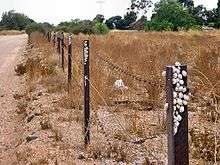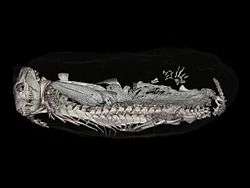Aestivation
| Part of a series on |
| Animal dormancy |
|---|

Aestivation or æstivation (from Latin: aestas, summer, but also spelled estivation in American English) is a state of animal dormancy, similar to hibernation, characterized by inactivity and a lowered metabolic rate, that is entered in response to high temperatures and arid conditions.[1] It takes place during times of heat and dryness, the hot dry season, which are often the summer months.
Invertebrate and vertebrate animals are known to enter this state to avoid damage from high temperatures and the risk of desiccation. Both terrestrial and aquatic animals undergo aestivation.
Organisms who aestivate appear to be in a fairly "light" state of dormancy, as their physiological state can be rapidly reversed, and the organism can quickly return to a normal state. A study done on Otala lactea, a snail native to parts of Europe and Northern Africa, shows that they can wake from their dormant state within ten minutes of being introduced to a wetter environment. Fossil records show that the act of aestivating may be several hundred million years old.
The primary physiological and biochemical concerns for an aestivating animal are to conserve energy, retain water in the body, ration the use of stored energy, handle the nitrogenous end products, and stabilize bodily organs, cells, and macromolecules. This can be quite a task as hot temperatures and arid conditions may last for months. The depression of metabolic rate during aestivation causes a reduction in macromolecule synthesis and degradation. To stabilize the macromolecules, aestivators will enhance antioxidant defenses and elevate chaperone proteins. This is a widely used strategy across all forms of hypometabolism. These physiological and biochemical concerns appear to be the core elements of hypometabolism throughout the animal kingdom. In other words, animals who aestivate appear to go through nearly the same physiological processes as animals that hibernate.[2]
Invertebrates


Molluscs
Gastropoda: Some air-breathing land snails, including species in the genera Helix, Cernuella, Theba, Helicella, Achatina and Otala, commonly aestivate during periods of heat. Some species move into shaded vegetation or rubble. Others climb up tall plants, including crop species as well as bushes and trees, and will also climb man-made structures such as posts, fences, etc.
Their habit of climbing vegetation to aestivate has caused more than one introduced snail species to be declared an agricultural nuisance.
To seal the opening to their shell to prevent water loss, pulmonate land snails secrete a membrane of dried mucus called an epiphragm. In certain species, such as Helix pomatia, this barrier is reinforced with calcium carbonate, and thus it superficially resembles an operculum, except that it has a tiny hole to allow some oxygen exchange.
There is decrease in metabolic rate and reduced rate of water loss in aestivating snails like Rhagada tescorum,[3] Sphincterochila boissieri and others.
Arthropods
Insecta: Lady beetles (Coccinellidae) have been reported to aestivate.[4] Mosquitoes also are reported to undergo aestivation.[5] False honey ants are well known for being winter active and aestivate in temperate climates.
Crustacea: Many land crabs spend dry seasons in an inactive state at the bottom of their burrows.
Vertebrates
Reptiles and amphibians

Non-mammalian animals that aestivate include North American desert tortoises, crocodiles, and salamanders. Some amphibians (e.g. the cane toad and greater siren) aestivate during the hot dry season by moving underground where it is cooler and more humid. The California red-legged frog may aestivate to conserve energy when its food and water supply is low.[7]
The water-holding frog has an aestivation cycle. It buries itself in sandy ground in a secreted, water-tight mucus cocoon during periods of hot, dry weather. Australian Aborigines discovered a means to take advantage of this by digging up one of these frogs and squeezing it, causing the frog to empty its bladder. This dilute urine—up to half a glassful—can be drunk. However, this will cause the death of the frog which will be unable to survive until the next rainy season without the water it had stored.[8]
The western swamp turtle aestivates to survive hot summers in the ephemeral swamps it lives in. It buries itself in various mediums which change depending on location and available substrates.[9] Because the species is critically endangered, the Perth Zoo began a conservation and breeding program for it. However, zookeepers were unaware of the importance of their aestivation cycle and during the first summer period would perform weekly checks on the animals. This repeated disturbance was detrimental to the health of the animals, with many losing significant weight and some dying. The zookeepers quickly changed their procedures and now leave their captive turtles undisturbed during their aestivation period.
Fish
African lungfish also aestivate.[10][11]
Mammals
Although relatively uncommon, a small number of mammals aestivate.[12] Animal physiologist Kathrin Dausmann of Philipps University of Marburg, Germany, and coworkers presented evidence in a 2004 edition of Nature that the Malagasy fat-tailed dwarf lemur hibernates or aestivates in a small tree hole for seven months of the year.[13] According to the Oakland Zoo in California, East African hedgehogs are thought to aestivate during the dry season.[14]
See also
References
- ↑ Miller, William Charles (2007). Trace Fossils: Concepts, Problems, Prospects. Elsevier. p. 206. ISBN 978-0-444-52949-7.
- ↑ Storey, Kenneth B.; Storey, Janet M. (2012). "Aestivation: signaling and hypometabolism". The Journal of Experimental Biology. 215 (8): 1425–1433. doi:10.1242/jeb.054403. PMID 22496277.
- ↑ Withers, Philip; Pedler, Scott; Guppy, Michael (1997). "Physiological adjustments during aestivation by the Australian land snail Rhagada tescorum (Mollusca: Pulmonata: Camaenidae)". Australian Journal of Zoology. 45 (6): 599–611. doi:10.1071/ZO97009.
- ↑ Hagen, Kenneth S. (1962). "Biology and ecology of predaceous Coccinellidae". Annual Review of Entomology. 7: 289–326. doi:10.1146/annurev.en.07.010162.001445.
- ↑ Charlwood, JD; Vij, R; Billingsley, PF (2000). "Dry season refugia of malaria-transmitting mosquitoes in a dry savannah zone of east Africa". American Journal of Tropical Medicine and Hygiene. 62 (6): 726–732.
- ↑ Fernandez, V.; Abdala, F.; Carlson, K. J.; Cook, D. C.; Rubidge, B. S.; Yates, A.; Tafforeau, P. (2013). Butler, Richard J, ed. "Synchrotron Reveals Early Triassic Odd Couple: Injured Amphibian and Aestivating Therapsid Share Burrow". PLoS ONE. 8 (6): e64978. doi:10.1371/journal.pone.0064978.
- ↑ Moore, Bob (29 September 2009). "Estivation: The Survial Siesta". Audubon Guides. Retrieved 5 September 2012.
- ↑ Pough, F. H.; Andrews, R. M.; Cadle, J. E.; Crump, M. L.; Savitzky, A. H.; Wells, K. D. (2001). Herpetology, second edition. Upper Saddle River, New Jersey: Prentice Hall.
- ↑ Burbrige, Andrew; Kuchling, Gerald (2004). Western swamp tortoise (Pseudemydura umbrina) recovery plan (PDF) (3 ed.). Perth, Western Australia: Dept. of Conservation and Land Management. Retrieved 26 November 2015.
- ↑ Delaney, R. G.; Lahiri, S.; Fishman, A. P. (1974). "Aestivation of the African lungfish Protopterus aethiopicus: cardiovascular and respiratory functions" (PDF). Journal of Experimental Biology. 61 (1): 111–128.
- ↑ Fishman, A. P.; Galante, R. J.; Winokur, A.; Pack, A. I. (1992). "Estivation in the African lungfish". Proc. Am. Philos. Soc. 136 (1): 61–72. JSTOR 986798.
- ↑ McNab, Brian Keith (2002). The physiological ecology of vertebrates: a view from energetics. Cornell University Press. p. 388. ISBN 978-0-8014-3913-1.
- ↑ Dausmann, Kathrin H.; Glos, Julian; Ganzhorn, Jörg U.; Heldmaier, Gerhard (2004). "Physiology: hibernation in a tropical primate". Nature. 429 (6994): 825–826. doi:10.1038/429825a. PMID 15215852.
- ↑ "East African Hedgehog". Oakland Zoo. Retrieved 5 September 2012.
Further reading
- Navas, Carlos Arturo; Carvalho, José Eduardo (2009). Aestivation: Molecular and Physiological Aspects. Springer. ISBN 978-3-642-02420-7.
External links
| Wikimedia Commons has media related to Aestivation. |
| Look up aestivation in Wiktionary, the free dictionary. |
- Abstract of an Australian paper on aestivation in snails
- Some info in aestivation in the snail Theba pisana
- Hibernation on demand
- Basic definition